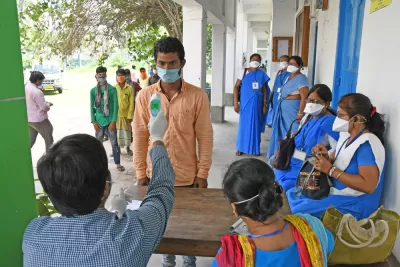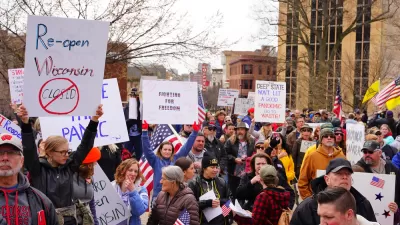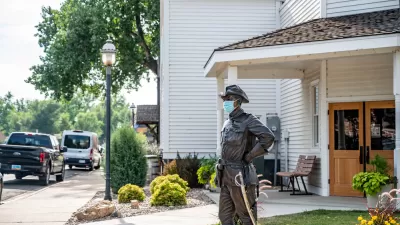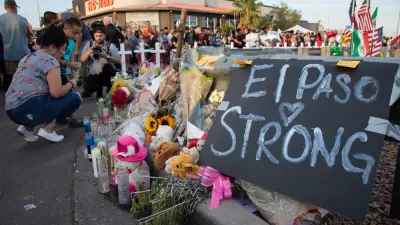India could be on track to overtake the United States in the number of COVID-19 cases. The surge is explained by a sharp and growing urban-rural divide in the ability and willingness to follow public health measures.

On Oct. 11, India's coronavirus caseload topped 7 million, having reported almost 75,000 cases in the prior 24 hours. On Oct. 10, the U.S. reported over 51,000 cases, with a 7-day average of 48,000 cases, according to The New York Times U.S. coronavirus tracker. Less than 740,000 cases separated the two most infected nations in the world on Oct. 12, according to The New York Times world coronavirus tracker.
"The coronavirus is spiraling out of control in rural India, where efforts to contain the virus have faced a significant backlash," wrote Lara Takenaga in The New York Times' Coronavirus Briefing newsletter for Oct. 9.
The situation has put India on track to have the most reported infections in the world: While the nation currently has 6.9 million cases [see the Times' India Covid Map and Case Count for current data] compared with 7.6 million in the United States, it is adding about 30,000 more cases a day than the U.S.
A sharp contrast divides India’s urban centers, where public health campaigns have helped to quell the virus, and the rest of the country, where many people think the government has exaggerated the pandemic and doesn’t understand their economic hardship.
In many villages, people don’t wear masks or practice social distancing. Residents often refuse to be tested, which carries a social stigma, and hide that they are sick.
The consequences are now clear: Rural hospitals are running out of beds and struggling to provide oxygen to patients.
There may be parallels to draw with the U.S., where daily infections have increased in 42 states during the last week, according to The Washington Post U.S. coronavirus tracker on Oct. 12. Midwestern and Mountain States, predominantly rural, led by North and South Dakota, Montana, Wisconsin, Utah, and Idaho, respectively, dominate the 15 red zone states that top 25 daily new cases per 100,000 people.
"The seven-day rolling average for new cases — considered a more accurate metric than the number of new cases reported each day — reached new highs in Alaska, Colorado, Indiana, Minnesota, Montana, Nebraska, New Mexico, North Dakota, Ohio, Oklahoma, Oregon, South Dakota and Wisconsin during the week that ended Sunday [Oct.11]," according to The Washington Post.
Rural hospitals are particularly hard hit. North Dakota, with "fewer than 20 staffed ICU beds available," are sending some patients out-of-state, reports CNN. North Dakota has resisted mask-wearing mandates on both the state and local levels.
Urban-rural coronavirus divide in India
"Infections are rippling into every corner of this country of 1.3 billion people," report Karan Deep Singh and New Delhi-based correspondents for the Times (source article). "The Indian news media is calling it 'The Rural Surge.'”
In recent trips to more than a dozen rural areas spread across several states, from Tamil Nadu in the south to West Bengal in the far east, to Tripura, Bihar and Uttar Pradesh in the north, the reaction to the pandemic appeared to be completely different from that of the big cities like Delhi and Mumbai.
Out in the rural areas, many people behave as if there is no coronavirus. Even many police officers who have been empowered to enforce the pandemic rules are not wearing masks.
In one important way, though, the Indian response differs from that of the U.S.—leadership at the top.
While President Donald Trump defiantly removed his mask upon returning Monday, Oct. 6 from Walter Reed National Military Medical Center where he spent the weekend receiving a mix of experimental treatments used in more severe cases of COVID-19, "Prime Minister Narendra Modi has 'spoken on all available platforms and underlined the need and importance of wearing masks and maintaining physical distancing,' said Manisha Verma, a spokeswoman for India’s health ministry," add Singh and The government’s focus, she said, has been on changing behavior rather than enforcement."
Case incidence rate
Finally, it's important to distinguish between total coronavirus cases and the per capita infection rate. India's diagnosed 504,433 cases during the last week amount to 37 cases per 100,000 people, the same as Canada's rate, according to the Times tracker. The 337,791 cases in the U.S. last week equal 102 cases per 100k, just shy of three times higher.
Related in Planetizen:
-
Wisconsin in Crisis, Oct. 11, 2020
-
Can the Public Be Educated to Wear Masks? Oct. 5, 2020
-
Britain Shuts Down and India Locks Down to Contain COVID-19, March 26, 2020
FULL STORY: ‘Rural Surge’ Propels India Toward More Covid-19 Infections Than U.S.

Planetizen Federal Action Tracker
A weekly monitor of how Trump’s orders and actions are impacting planners and planning in America.

Congressman Proposes Bill to Rename DC Metro “Trump Train”
The Make Autorail Great Again Act would withhold federal funding to the system until the Washington Metropolitan Area Transit Authority (WMATA), rebrands as the Washington Metropolitan Authority for Greater Access (WMAGA).

The Simple Legislative Tool Transforming Vacant Downtowns
In California, Michigan and Georgia, an easy win is bringing dollars — and delight — back to city centers.

The States Losing Rural Delivery Rooms at an Alarming Pace
In some states, as few as 9% of rural hospitals still deliver babies. As a result, rising pre-term births, no adequate pre-term care and "harrowing" close calls are a growing reality.

The Small South Asian Republic Going all in on EVs
Thanks to one simple policy change less than five years ago, 65% of new cars in this Himalayan country are now electric.

DC Backpedals on Bike Lane Protection, Swaps Barriers for Paint
Citing aesthetic concerns, the city is removing the concrete barriers and flexposts that once separated Arizona Avenue cyclists from motor vehicles.
Urban Design for Planners 1: Software Tools
This six-course series explores essential urban design concepts using open source software and equips planners with the tools they need to participate fully in the urban design process.
Planning for Universal Design
Learn the tools for implementing Universal Design in planning regulations.
Smith Gee Studio
City of Charlotte
City of Camden Redevelopment Agency
City of Astoria
Transportation Research & Education Center (TREC) at Portland State University
US High Speed Rail Association
City of Camden Redevelopment Agency
Municipality of Princeton (NJ)





























